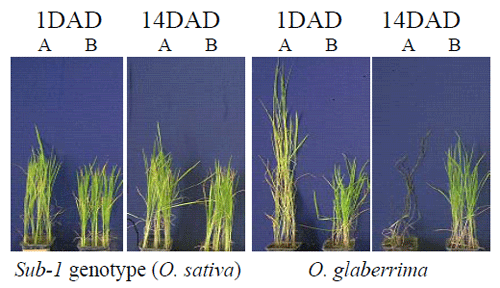Flash flood tolerance of Asian rice, African rice and interspecific hybridization progeny, (NERICA)
Description
In the coastal areas and river basin of Guinea in West Africa, flash floods occur frequently following heavy rain during the rainy season. And, young rice seedlings are particularly vulnerable to submergence. Flash flood tolerance is hereby defined as “survival to complete submergence within 10 days”. Rice plants can supply oxygen from shoot to root through their parenchyma. However, the oxygen supply is limited due to complete submergence, which results in adverse effects on the oxygen metabolism in these rice plants. Therefore, the flash flood-tolerant ability of rice is important in flash flood-prone areas. The objective of this study is the identification of important traits to flash flood tolerance using the wide genetic resources of rice in the African environment. This study was conducted through pot and field experiments for two years in Guinea.
Fifteen day-old rice seedlings were submerged for 7 days. Flash flood tolerance was evaluated by the ratio of dry matter weight (DMW) of submerged plants to non-submerged plants at 14 days after de-submergence. Shoot elongation during submergence showed a negative correlation with flash flood tolerance (Fig. 1).
The physiological traits of flash flood-tolerant genotypes including Sub-1 gene are short shoot elongation during submergence and high ratio of DMW of submerged plants to non-submerged plant at 14 days after de-submergence (Fig. 1 and 2).
Most of the African rice (O. glaberrima Steud.) genotypes showed higher shoot elongation during submergence and there was a lower ratio of DMW of submerged plants compared to non-submerged plants at 14 days after de-submergence (Fig. 1 and 2). However, Saligbeli (African rice) showed higher shoot elongation during submergence and higher ratio of DMW of submerged plants to non-submerged plants at 14 days after de-submergence.
It is necessary for flash flooded plants to adapt to environmental changes of lowered oxygen condition during submergence to aerobic condition after the water has receded. The important traits related to flash floods are shoot elongation during submergence, lodging resistance after de-submergence and increase in DMW (Fig. 3).
From the results of a principal component analysis, the first and second factors include 74% of the information of these three traits. The first factor axis shows the traits of flash flood tolerance (Fig. 3).
The rice genotypes which include the Sub-1 gene shows flash flood tolerance, and African rice cultivars, except for Saligbeli, are shown to be sensitive to flash floods in Guinea.
The study of physiological characters which included dry matter production in flash flood-tolerant cultivars and Saligbeli is important to understand the physiological mechanisms of flash flood tolerance.
The above three indexes are applied to the simple evaluation of flash flood tolerance.
Figure, table
-
Fig. 1. Effect of shoot elongation on the ratio of dry matter weight of submerged plants to non-submerged plants at 14 days after de-submergence -
Fig. 2 Plant growth of flash flood-tolerant cultivar and African rice cultivar after de-submergence.
1 and 14DAD indicate one day and 14 days after de-submergence, respectively. A and B indicate plants in submergence plot and in control plot ,respectively. -
Fig. 3 Correlation patterns of characteristics projected on the plane defined by the first and second factors’ axes.
[[{"fid":"89979","view_mode":"wysiwyg","fields":{"format":"wysiwyg","field_file_image_alt_text[und][0][value]":false,"field_file_image_title_text[und][0][value]":false},"type":"media","field_deltas":{"8":{"format":"wysiwyg","field_file_image_alt_text[und][0][value]":false,"field_file_image_title_text[und][0][value]":false}},"attributes":{"class":"media-element file-wysiwyg","data-delta":"8"}}]] -
Fig. 4 Evaluation of flash flood tolerance by the principal component analysis.
The symbols are the same as Fig. 1.
- Affiliation
-
Japan International Research Center for Agricultural Sciences Crop Production and Environment Division
- Classification
-
Technical A
- Term of research
-
FY2007(FY2006~2010)
- Responsible researcher
-
SAKAGAMI Jun-Ichi ( Crop Production and Environment Division )
- ほか
- Publication, etc.
-
Kawano, N., Ito, O., and Sakagami, J-I.(2008) Flash flooding resistance of rice genotypes of Oryza sativa L.,O. glaberrima Steud., and Interspecific hybridization progeny. Environmental and Experimental Botany. 63,9-18.
Kawano, N. and Sakagami, J-I.(2008) Submaergence stress to rice plants in West Africa. JIRCAS Working Report, No.57, 25-36.
Kawano, N., Ito, O., and Sakagami, J-I.(2007) Morphological and physiological responses of rice seedling to flash floods. Abstract of 9th Conference of the International Society for Plant Anaerobiosis, 27.
Kawano, N., Ito, O., and Sakagami, J-I.(2006) Flash flooding resistance of rice genotypes of Oryza sativa L.,O. glaberrima Steud., and Interspecific hybridization progeny. In Africa Rice Congress.
Kawano et al. (2006) Abstracts of the meeting of the Crop Science Society of Japan. Vol221, 206-207.
- Japanese PDF
-
2007_seikajouhou_A4_ja_Part5.pdf491.6 KB




